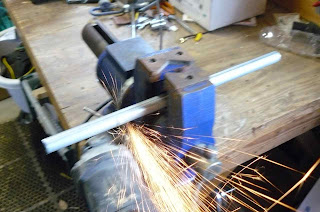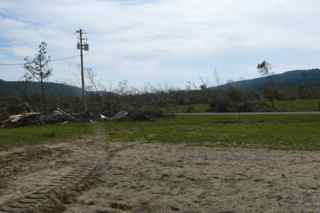Friday, May 13, 2011
Movie review: King Corn
Friday, May 6, 2011
Alabama Disaster Relief
Monday, April 11, 2011
Buying local
Wednesday, March 23, 2011
Quick update
Possible future topics:
Buy-local Philosophy
Composting *Feels the readers' excitement. woo.*
Timber Framing: multi-generational agrarianism
Rotational Grazing
100% Grass-fed Dairying
Milk Stanchions
Stay tuned, because I will likely scrap all of these topics and blog about something totally different.
Anyhow, here is what's been going on in the life of this farmer:
- Garden prep: tilling, compost hauling, soil blocks.
- House construction: trim, siding, caulking *oh yeah*
- Timber frame construction: cutting, raising
- Disassembling timber frame "temporary" bracing: Ring-shank nails + seasoned white oak = disaster.
- Cross fencing dairy pasture: hopefully this will maximize chore efficiency
- Cleaning up the shop: still looks like a tool-bomb went off.
- Getting over a broken finger and shoulder injury: *figures*
- Training Hoss...the ever loyal but sometimes pesky Great Pyrenees
Monday, February 21, 2011
Maple syrup - evaporating
In Middle Tennessee, it takes approximately 50 gallons of raw sap to make 1 gallon of finished syrup.
Making Syrup from the sap
In a nutshell: build a fire and find a pot. Not mom's nice cookware. Trust me, that goes over like a lead balloon. I use an old stainless pressure canner to evaporate my sap. Add sap to pot. Do not fill the pan/pot completely or it will boil over. The more violent the boil, the faster the water evaporates. If foaming occurs, skim it off with a fine strainer. Continually add more sap as it evaporates. Carefully monitor the syrup, never letting the level of the liquid get below 1.5". If it gets any lower it will scorch.
Finishing the syrup
When you are ready to finish the syrup (basically when you run out of sap), stop adding sap, and continue the evaporation process until the liquid is boiling at a temperature of 106 degrees Celsius (or 6 degrees over boiling point in your location). We usually finish the syrup over the stove because it is easier to control the heat. Finishing the syrup to the correct temperature is critical for the syrup to achieve optimum viscosity.
Evaporators don't have to be fancy. Just a fire and a pot will work. Here are some pictures of my current cinder-block evaporator prototype:
Saturday, February 19, 2011
Maple syrup - tapping
Oh, but it is. There is nothing like homemade maple syrup from your own trees. Not only does it have an awesome flavor, but making it is a very enjoyable, easy process.
Where to start?
Identifying the trees is as good a place as any. Sugar maples, silver maples, and red maples may all be tapped as long as they are at least 1.5 feet in diameter. Sugar maples are ideal because their sap contains the highest concentration of sugar. Yeah, I know, right? The higher sugar content, the less it has to be boiled down.
When to tap:
We tap our trees in February and collect sap until early March. Maple sap flows after a hard freeze, followed by a temperature swing up into the 40 degree range. The sap flow will cease when the temperature does not rise above freezing during the day or drop below freezing at night.
Equipment:
- 1/2" aluminum conduit
- angle grinder or hacksaw
- 5gal. buckets with lids
- nails
- hammer
- 5/8" auger bit
- cordless drill





 If the tree is larger than 24" in diameter, it can support 2 taps.
If the tree is larger than 24" in diameter, it can support 2 taps. Voila! Now the sap will drip into the buckets and be ready for collection and evaporation.
Voila! Now the sap will drip into the buckets and be ready for collection and evaporation.Thursday, February 17, 2011
Rose Colored Glasses
Farmer Jake got up at 4:45am one summer morning, bright-eyed and bushy-tailed, to skip down the sunny, tree-lined driveway, and fetch Daphne the sweet milk cow. [Farmer Jake actually crawled out of bed with his eyes all puffy, he and stumbled all the way down to the barn in the dark before he realized he left the milk bucket at the house] Daphne moo'd for joy and skipped to the barn with Farmer Jake. [Daphne actually had a long night and didn't feel like walking to the barn, so Farmer Jake pushed her all the way] Farmer Jake patiently brushed Daphne to make her furry back all glossy [and get off the cow patty she managed to get on her side, which got the brush so nasty it had to be washed before continuing] Within minutes he had a full bucket of nice cold milk. [well he would have gotten some milk if the calf hadn't gotten into Daphne's pasture...but the milk would have been warm. Oh, and, turns out, he wasted 10 minutes going to get the milk bucket he didn't need] True story. After a filling breakfast of sausage, bacon, country ham, biscuits, toast, orange juice, and coffee [oatmeal: quick and cheap] he saunters out to pick the strawberries. 'Nother story for 'nother time.
Take off the rose colored glasses. Please. Farming is hard. Especially if it is not a hobby but an bona fide business. It's not all about sitting in a rocking chair watching the corn grow, or taking a nap under the shade tree. There is always a huge list of things that need to be done.
Don't get me wrong. We take some time to do fun stuff, and I love farming. I love farm life. What other occupation do you get to experience God's creation more? Watching a calf grow or seeds germinate is pure awesomeness. Sure, there is a lot of nitty-gritty, downright hard work, but it's worth it. It's not what I really expected five years ago, though. I had Rose Glasses Syndrome for a while there, too. I think everybody does to some extent.
Just to solidify what I just said...I was typing this blog entry while boiling down maple syrup last night (next post) at 3:30am (I had started boiling it at 5:30pm). I checked on the fire and the syrup needed to boil for about 5 more minutes. Great. Just enough time to finish my blogging! I woke up at 4:00am with my MacBook still open in my lap. Panic struck. *Kronk Voice:* "*gasp*My maple sap!" To make a long story short, I burnt 8 hrs. worth of work...proly at least a gallon of finished product. When I went outside it was foaming/bubbling candy-like out of the pot. This morning I had the uber pleasant chore of cleaning candied charcoal off the pot. It's not the end of the world, though. Life will march on, and I am determined to enjoy every step of the way...mostly.







































